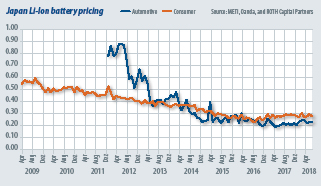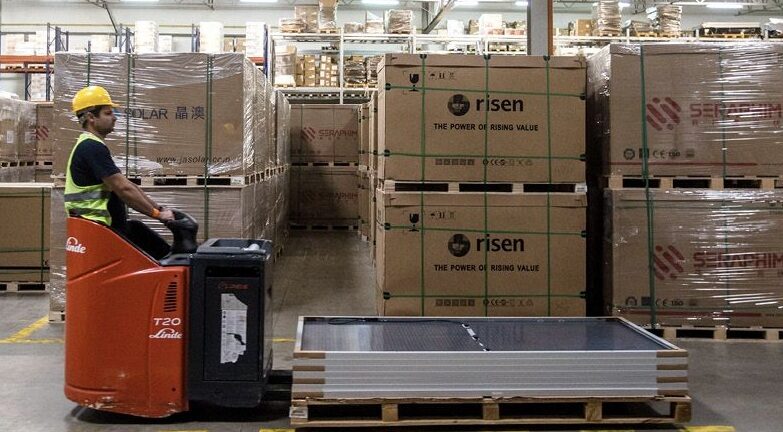From pv magazine, November edition
Public enthusiasm for lithium-ion storage solutions that should lift growth rates and enable high-level penetration for renewables has helped drive robust activity, but this technology is not without complicating factors. We understand lithium-ion cell prices are slated to increase around 5%-15% in 2019, as commodity cost increases roll through.
The seismic importance here cannot be underestimated. Utility scale project developers have been bidding PV projects two to three years ahead, anticipating the continued cost down of PV. They have been right and rewarded handsomely. These project owners and developers are now counting on continued battery cost reductions that may not materialize, or at least not on the desired timeline, to make many storage projects viable.
We are long-term supporters of the energy storage industry; and are concerned that overly optimistic cost-out forecasts for batteries could wreak havoc on future energy storage market development. Similar weak quality logic was used a decade ago to push investments in battery production for EVs, and yes these projects may have been disappointing, but the outcome was positive, as lithium was always the only clearly viable solution. We see today’s market distortion differently, as overemphasis on lithium technology has pulled appropriate investment away from other battery technologies that could outperform on both installed and levelized cost metrics.
Postive sentiment vs reality
Twenty years on Wall Street, almost entirely in CleanTech, has taught me how during periods of market enthusiasm, estimates will be pro-cyclical, tracking largely with sentiment. Positive sentiment for lithium storage is undeniable, and we too are bullish (small “b”). Where things break down, is when discussion of market pricing and volumes separates from reality. We can’t fault OEMs for wanting to share a competitive outlook when a neighbor suggests an overly optimistic view on how prices are heading lower, but only a few iterations can start a much wider game of liar’s poker.
We closely follow the Japanese Ministry of Trade and Industry (METI) for quality data on lithium battery cell volume and price trends (see graph below). METI data often diverges widely from pricing estimates shown by analysts and consultants. This data shows consumer lithium battery pricing as sometimes volatile, yet mostly flat for the past three years, after the prior five years of moderate cost reductions.
Looking at METI’s data series for automotive also shows some impressive medium-term price improvement, as expected, but more recently prices seem to be increasing. This differs greatly from the conventional wisdom where many believe costs are dropping by over 20% a year and expect significant cost reductions to continue to the horizon.

Image: pv-magazine
Cost optimization through technology
The big opportunities for lower prices in lithium ion batteries come from silicon anode technology, and solvent-free manufacturing. We expect silicon anodes to reach commercial scale in consumer applications first, where there is less sensitivity to higher initial prices, as these cells will likely come at a higher cost. After a sustained period of years on the market we expect silicon anode cells to have superior economics, primarily for squeezing more juice into the box. Time will tell.
Everyone check your watches in five years? Solvent-free manufacturing for battery electrodes has the potential to reduce capital costs by over 50% for a lithium cell production facility, but experience here points to major challenges. This has been tried at Electrovaya, Gore, Johnson Controls, Maxwell Technologies and others, with Maxwell’s simpler carbon UCap electrodes currently the only commercial dry extruded product. Customers point to batch-to-batch, and even intra-batch variance in electrode thickness as a major problem for reliable cell assembly.
Alternatives to Li-ion
We believe second generation battery technologies are an equally credible solution that merits greater investment than has been garnered in the past couple years. Comparisons against hard data like that available from METI, instead of wishful thinking on the part of the most aggressive competitors or echoes here in analyst forecasts, shows a cost gap today for many proposed solutions that is much smaller than perceived.
In our view, the full portfolio of technologies – zinc bromide flow, vanadium flow, metal air secondary, advanced lead acid, low cobalt lithium ion, solid state lithium ion, lithium sulfur, and others – all deserve a much closer look. We are not saying second generation technology is a certainty, but manufacturing a flow battery for example, is a lot like making a washing machine, so cost/volume forecasts are something where we think engineers can have reasonable comfort.
The failure of second-generation PV was largely due to the absence of continued venture capital investment following the bankruptcy of Solyndra. Second generation biofuels flopped as many companies came public too early, and there was no sustained development cycle. For energy storage markets to work, we need reasonable expectations for the lithium battery price outlook, fair comparisons between technologies, and sustained development cycle for a portfolio of technologies and solutions.
Craig Irwin – ROTH Capital
This content is protected by copyright and may not be reused. If you want to cooperate with us and would like to reuse some of our content, please contact: editors@pv-magazine.com.



Now that lithium-ion is taking up big time and people rather have lithium ion, the lead acid battery needs to start falling in price, they haven’t budged their prices in tens of years! Right now lead acid does not look good as a battery source too high cost!!!
“The big opportunities for lower prices in lithium ion batteries come from silicon anode technology”
Pity silicon expands 3 x as much as Graphite and therefore is not safe.
The fact that Li-Ion battery prices are going up has little to do with commodity prices and a LOT to do with capacity issues. The rapid growth in storage and EVs has been faster than supply can maintain. However, looking at the build-out of new battery factories, the people in the industry are confident that this is a blip – similar to what happened in solar in 2010 or so when silicon prices shot up until more capacity came on line.
I agree that investment should happen for all storage technologies. Just don’t count out Li-Ion which went from “good for 30 minutes” to “good for 4 hours” in less than 5 years. The technology improvements and scaling have just started! We are going to see solid state batteries that don’t care how fast they charge and discharge in the not too distant future. Because Li-Ion is the key to EV, the big money is there to take each small or large improvement from lab to production much more quickly than any other storage technology.